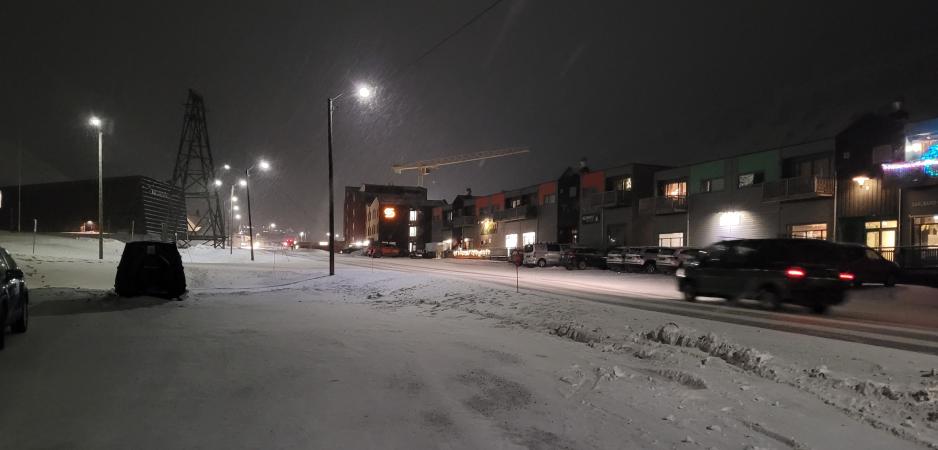The Arctic is Dark, Darker Than Ever

Darkness surrounds Longyearbyen around-the-clock. This winter seems especially dark. (Photo: Arne O. Holm)
(Commentary) Longyearbyen: Two news notifications flash on my cellphone as my flight from Tromsø lands in Longyearbyen on Svalbard. One of the notifications reads that the government is preparing a new Svalbard white paper. The other is a greeting from Dimitrij Medvedev, former Russian Prime Minister and President, and explains the need for a new white paper.
The flight from the mainland to Norway's actual Arctic at 78 degrees north is surprisingly full of excited tourists on this January day. I have worked as a guide in Svalbard for many years and know that not all tourists who travel at this time of the year are prepared for the round-the-clock, deafening darkness which consumes the island's nature. A faint glimpse of light from the Russian city of Barentsburg can be seen in the distance from the airplane window. The sun does not appear for the people of Longyearbyen until the 8th of March and that is still a long time away.
A nuclear power
The darkness does not cast any shadows either.
However, the news release from Dimitrij Medvedev does.
"If a nuclear power loses in a conventional war, it could trigger a nuclear war," the former president is quoted saying.
The darkness does not cast any shadows either.
According to the NATO Secretary General, Jens Stoltenberg, Russia will lose the "conventional" war in Ukraine. I put quotation marks around conventional. There is nothing conventional in bombing schools and apartment buildings. It is a blood-thirsty hell.
I am in Longyearbyen to give a lecture titled "What is it about the Arctic?". The title was set almost two years ago, but the pandemic put a stop to the annual Svalbard seminar held by the governor and the University Centre in Svalbard.
It would regardless have been a completely different lecture back in 2020. Russia's war against Ukraine has made sure of that.
New white paper
For the same reason, the Norwegian government is preparing a new Svalbard white paper. Normally, such status reports come every tenth year. The previous one came in 2016. The government does not have time to wait.
The marching order came from the East, from the Russian owners of extreme weapons located on the Kola Peninsula on the border to Norway. Weapons that particularly sail below the sea surface off the coast of the archipelago Svalbard.
Weapons that sail off the coast of Svalbard.
High North News has through several articles documented how Russia has increased its military capacity in the north. While we are confronted daily by news reports on the lack of weapons, low morale, and worn-out Russian soldiers in Ukraine, the situation is quite different along the northwest coast of Russia.
There is nothing worn out about the nuclear submarines, aircraft, or warships located here. Nor about the bunker facilities which house the Russian nuclear weapons when they are not voyaging towards the US, for example.
The other Russian sailing routes out into the world are more or less closed. The Baltic Sea has become an integrated part of NATO because of Finland and Sweden's applications. But Russia also meets NATO in the Black Sea as long as the war against Ukraine continues.
Risk of conflict
In this image, Svalbard's location becomes increasingly strategically important. In this image, the risk of armed conflict in the Arctic increases. Therefore, the government does not try to hide that security policy issues is precisely why we need a new Svalbard white paper. It is a brand-new, official justification, which simultaneously explains measures already implemented by the government. Measures that, without exceptions, aim to strengthen the Norwegian control of Svalbard.
Foreigners, however long they have lived in Longyearbyen, have abruptly been robbed of their right to vote and their political influence, the gun laws and gun controls have been strengthened, tourism both on land and at sea is becoming more and more regulated, and the state is buying up private properties that are put up for sale.
With small steps, Longyearbyen is moving away from descriptions of a robust family community towards more traditional Arctic outposts. How long the government is willing to go in this direction we will not know until the white paper is presented. A society where the population is a strategic means also needs kindergartens, stores, culture, and other services.
Local government?
But do such societies need their own municipal council or local government, as it is called up here?
A democracy introduced with almost acclamation and champagne 20 years ago, but which now remains a shadow of itself. Just as most reforms and strategies in Svalbard are reversed after a few years, the local democracy is also a reform that is on a steep decline.
When the mining industry was shut down, tourism was supposed to save the community. That was so successful that tourism is now under attack.
Four billion against four million.
For a long time, investments were made in private businesses, innovation, and private housing construction. That has also been successful enough that measures are now being taken to bring the development into public hands.
The price mechanism also affects everyday life in Longyearbyen. At an almost desperate pace, attempts are being made to phase out the coal-fired power plant in favor of diesel plants. Electricity prices are skyrocketing and the same applies to housing prices in a market increasingly more regulated by the state. If you are in the rental market, you will get more for your money by renting an apartment in the finest area of Oslo than in Longyearbyen. This too has major consequences for a tourism industry known for its low wages.
Roughly four billion people in Russia, China, the USA, India, and Europe have laid their eyes on the Arctic. They do so because of security policy reasons and they do it to ensure energy for their own industry and economy.
They do it almost entirely without seeing the Arctic human.
Four billion people against four million Arctic people.
Pieces in a dangerous political game.
The government is right in reviewing its Svalbard policy. Now it remains to see if it also does the right thing for the people who live or want to live here.
It might not be the same people.
Also read
This commentary was originally published in Norwegian and has been translated by Birgitte Annie Molid Martinussen.


